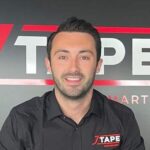How to Prevent and Remove Overspray When Painting a Car
Overspray can be a big obstacle to overcome for those working in automotive paint booths. It can be difficult to remove, almost impossible to avoid and, more often than not, will waste your time and resources. But the negative effects don’t end in the repair shop, either.
If paint overspray is left on the vehicle or proper procedures for removal aren’t followed, this can affect the overall finish of the vehicle. Of course, this can lead to dissatisfied customers and build a bad reputation for the quality of your paintwork.
Therefore, learning how to minimise and prevent overspray is essential when you regularly work in an automotive paint booth. Here, we’ll be explaining in more depth why overspray is such an issue in the automotive industry, the precautions you can take to avoid it and the best ways to remove it without leaving any damage behind.
What is Overspray in Automotive?
Overspray in the automotive industry refers to any unwanted paint particles that end up on the surface of the vehicle. Often, the particles are light enough to float around in the air, before eventually landing on the surface, hardening, and becoming what’s known as overspray. The most obvious example of this is when wet paint mist from a nearby application lands on adjacent panels or parts of the vehicle’s surface. However, overspray can also occur when stains, varnishes and other equipment are used close to the surface of vehicles in your auto repair shop.
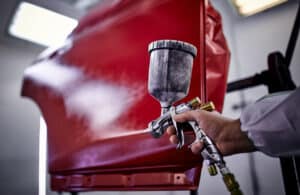
Regardless of how the overspray occurs, these situations can lead to a poor-quality, rough finish overall, not to mention compromising the integrity of the paint job. Sometimes it doesn’t become visible until later down the line, but as time goes on, the overspray will undoubtedly become increasingly noticeable. The car owner will then need to fork out on additional paint repairs that they wouldn’t have needed to worry about if the overspray had been rectified originally.
What Causes Overspray in Car Painting?
The causes of overspray when painting a car in a spray booth are mostly down to the technique used. Below we’ll outline a few of the most common reasons you might experience this issue:
- Holding the paint gun nozzle at the wrong angle
- Improper use of the spray gun
- Allowing too much/not enough distance between the spray gun and the vehicle’s surface
- Lack of masking/using the wrong masking products for the job
- Too much air pressure from the spray gun causes the paint to bounce back
- A lack of air pressure from the spray gun means the paint is less likely to reach the intended area of the car’s surface
Issues Caused by Overspray
Overspray can cause several problems that make it difficult to remove and place it on top of your list of consequences to avoid. From lost time to wasted materials, below we’ll explain the true extent of the impact it can have on your automotive repair shop.
Time Lost
It often takes far longer to fix overspray than it does to simply avoid it in the first place. And as anybody working in the automotive industry will know, time resource is not something to mess with in such a fast-paced environment when you’re working to client deadlines. Overspray removal can be time-consuming because it requires careful work and lots of attention to detail to prevent further damage.
Wasted Materials
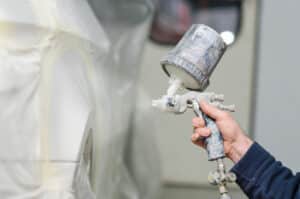
The more overspray you’re dealing with, the more paint is being wasted and the more money your repair business is flushing down the drain. It’s really that simple. If you find that your repair shop needs to repurchase automotive paint more frequently than it should, it could be due to issues with overspray leading to paint being wasted.
Dissatisfied Customers
If overspray is left on the vehicle, you’re more likely to face a disgruntled customer when it’s time to hand the keys back over. Overspray can affect the texture and appearance of a vehicle’s surface, which means that the customer isn’t necessarily receiving the quality of service that they expect. This can drastically affect your repair shop’s reputation and drive business away to competitors that don’t leave overspray on vehicles, which no auto repair shop wants.
Health Concerns
Overspray can be dangerous because it means that the paint could be circulating in the air in the repair shop. So while the person spraying in the booth should be protected by wearing a mask, others in the shop might not be. This poses a serious health risk since they could be breathing in harmful chemicals produced by some automotive paint types.
How to Prevent Overspray when Painting a Car
Learning how to prevent overspray will take practice. Professionals in the automotive painting industry must consider everything that could cause overspray and take as many necessary precautions as possible to stop it from happening. The tips and advice here can help minimise overspray and completely prevent it in most cases.
Use High Quality Masking Products
Masking can be the best way to prevent issues caused by overspray because film and tapes should sufficiently cover any areas that you don’t want to be sprayed. However, to fully avoid overspray, you’ll need to choose high quality specialist masking products intended for the specific paint application you’re working on. If you’re created blending edges, be sure to use dedicated blending tapes that can prevent harsh lines and create a seamless finish between new and old paintwork. Or, if you’re working on wheel repairs and painting alloys, use the JTAPE Wheel Repair Mask. Masking films and protection films can also make a huge difference when it comes to overspray because they can be applied to a range of surfaces to cover and protect them.
For our full range of excellent, high quality masking products, browse our product list.
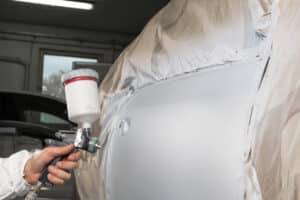
Be Sure to Properly Prepare the Vehicle & Paint Booth
By fully preparing the vehicle and spray booth for painting, you can help reduce the risk of overspray. Poor air quality within the booth can allow dust and particles to float down onto the vehicle’s surface and leave your paintwork textured and uneven. The air particles can also pick up the paint from the spray gun and drop it in areas that aren’t involved in the paint job at hand. To prevent this, invest in air quality control technology that will ensure your booth is suitable for any auto paint task. Proper ventilation is also necessary since this can filter the small particles out of the air.
The vehicle should also be adequately prepared before beginning the painting process. This means cleaning the surface thoroughly to remove dust, dirt and debris, carrying out any necessary repairs to a high standard and ensuring the surface is kept at the optimal temperature. All of these factors can impact how the paint is applied, and ensuring you’re keeping an eye on these will minimise the risk of overspray occurring.
Use Proper Painting Equipment
The quality of your painting equipment can have a huge impact on the amount of overspray you’re dealing with. Investing in a professional-grade spray gun with adjustable settings will allow precise control over the paint flow, pattern, and air pressure.
Maintenance of the equipment is also equally important. Regularly cleaning and looking after your painting tools will ensure optimal performance and prevent build-up that could lead to overspray.
Ensure Your Spray Gun is Adjusted to the Correct Settings
The air pressure of your paint can have a huge impact on paint flow. Choosing an air compressor with low CFM, for example, could leave you unable to produce enough paint flow for the job at hand. On the other hand, if the settings are set to a high CFM when you’re painting a smaller area, this could produce an excess of paint flow which creates overspray in the adjacent areas.
Many spray guns also have settings so that you can control the air pressure and paint viscosity. These should be adjusted to the manufacturer’s recommended level since an excess of pressure could lead to atomization issues and increased overspray. The paint manufacturer’s instructions can help determine the ideal viscosity for the specific paint type you’re using and help reduce overspray.
Master Your Technique
Tools and equipment can sometimes only take you so far. Even with the highest quality spray guns and automotive masking tapes, your painting technique can still affect the level of overspray. Therefore, it’s incredibly important to learn and practice the best painting techniques.
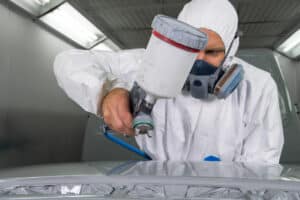
The angle and distance of the paint gun nozzle need to be spot on for the paint job at hand, whether you’re working on the entire car body or spot repairs. Both factors can have a big impact on the distance that your paint travels, while it’s also important to maintain a consistent distance from the target area.
How to Remove Car Overspray
Prevention is typically the best way to deal with overspray. However, if you do find yourself needing to remove it, the main thing to remember is that it should be done as quickly as possible. The longer the paint overspray is left to sit on the vehicle’s surface, the more difficult it will be to remove regardless of the method you choose. So as soon as you notice the overspray, we recommend getting to work and removing it immediately to give yourself the best chance of returning the surface to its original state.
Use a Clay Bar
A clay bar is typically the best and easiest way to remove overspray from most areas of a car’s surface. Using a rubbing motion, this tool can simply grab onto paint overspray and loosen it from the vehicle’s exterior.
How to Use a Clay Bar: Step by step
Start by washing the car’s exterior to ensure you’re working on a clean surface free from any debris, dust or paint that hasn’t settled in just yet.
We then suggest spraying a lubricant such as a degreaser or paint thinner to allow the clay bar to glide smoothly over the surface. The more you can apply the better, since this will prevent the bar from sticking to the surface and potentially causing abrasions.
Once a sufficient amount of lubricant is applied, you can begin rubbing the clay bar across the affected surface. Avoid applying excessive pressure that could damage the surface further, and instead allow the clay bar to work over the overspray. The process is likely to take a while depending on the amount of overspray you need to remove, but you will need to work quickly to pick up the excess paint particles.
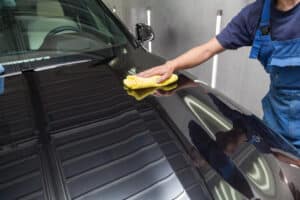
Precautions for clay bar use
Although the clay bar is the number one choice for removing overspray effectively, there are a few precautions to be aware of. Too much pressure or a lack of lubricant spray can cause scratches and abrasions to appear, which can end up dulling the appearance of the paint job over time. It’s important to start with light pressure and see what works best, but bear in mind that you should never need to be too heavy-handed with it.
As we’ve mentioned, removing overspray with a clay bar can also take longer, so remember to be patient with the process. Try to maintain similar pressure across the entire area, regardless of how long it takes. This will give you the best chance of smoothing out the texture and appearance.
Other Overspray Removal Methods
Depending on whether your paint is oil or acrylic-based, the removal method is likely to be slightly different. This will usually affect which type of lubricant is used since acrylic-based paint is easier to break down with just soap and water, while oil-based and tougher paint types might require paint thinner or degreaser.
If the clay bar method doesn’t work for you, a good alternative can be to use a putty scraper. This is usually best if you have a large quantity of overspray, or the paint used is tougher since it can be slightly harsher on the surface. However, this can also cause abrasions and cuts on the surface, which means it’s important to use light pressure. A putty scraper can also help remove overspray from glass and plastic areas of the car body.
Mastering the art of preventing overspray is essential for elevating your craftsmanship and delivering excellent results. By following the techniques and precautions outlined here, you can overcome the main challenges that arise with car paint overspray. One of the best ways to prevent overspray is to use quality masking products. At JTAPE, we’re proud to offer a diverse range of masking products suited to many different repair jobs in the automotive industry, from spot repairs to paint blending. Discover our full range of products today.


